|

|
|
 |
|
 |
|
 |
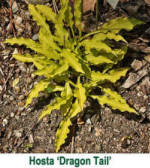
While entering information on over 15,000 hosta names in our
database, we have tried to be consistent with the terms and
definitions as defined in
The American
Hosta Society (AHS) procedures for
registering new
hosta cultivars. This is not always easy to accomplish since the
descriptions provided by various information sources such as
hosta books, online nurseries and catalogs often deviate from these
"official" form. So, we have tried our best to make them fit
into the
AHS format.
|
|
|
|
 |
|
 |
|
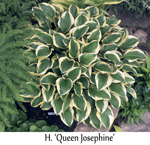 This
is the term used for a "cultivated variety" of a plant.
These names are written in a format that has a single
apostrophe ' before and after the name. Cultivars are
generally plants that have been propagated asexually
(not by seed) so that each plant of a certain cultivar
name is the same as every other plant with that name. An
example would be
Hosta 'Sum
and Substance'. This
is the term used for a "cultivated variety" of a plant.
These names are written in a format that has a single
apostrophe ' before and after the name. Cultivars are
generally plants that have been propagated asexually
(not by seed) so that each plant of a certain cultivar
name is the same as every other plant with that name. An
example would be
Hosta 'Sum
and Substance'.
 The names of cultivars
must meet certain standards set up
by the International Code of Nomenclature for Cultivate
Plants if they are to be properly registered. Also, there are many instances where
different plants have been given the
same name
or, a single plant is known or has been known by multiple names.
Unfortunately,
outdated or incorrect names may appear on
plant labels or in catalogs and books so we have included cross
references to dozens of "Duplicate Name" hostas in our
database. We have tried to bring some measure of order
to the often confusing top of hosta names. The names of cultivars
must meet certain standards set up
by the International Code of Nomenclature for Cultivate
Plants if they are to be properly registered. Also, there are many instances where
different plants have been given the
same name
or, a single plant is known or has been known by multiple names.
Unfortunately,
outdated or incorrect names may appear on
plant labels or in catalogs and books so we have included cross
references to dozens of "Duplicate Name" hostas in our
database. We have tried to bring some measure of order
to the often confusing top of hosta names. |
|
 |
 |
|
 |
|
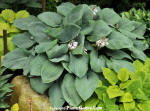  According to
the AHS, there are five official size categories for hostas
including Giant, Large, Medium, Small and Miniature.
In some information sources, actual measurements are
provided for the hosta clump's height and spread while in others, terms such as "medium to large"
or "tiny"
are used and needed to be interpreted by us to fit one of the 5
categories. According to
the AHS, there are five official size categories for hostas
including Giant, Large, Medium, Small and Miniature.
In some information sources, actual measurements are
provided for the hosta clump's height and spread while in others, terms such as "medium to large"
or "tiny"
are used and needed to be interpreted by us to fit one of the 5
categories.
Remember that sizes are based on physical measurements
of individual plants at one point in time. Unfortunately, sometimes that may
be based on measuring only one plant which may not be
"typical" or it may be an immature plant that has
more
growing to do in future seasons. Ideally, the
measurement should be made on a plant at least fiver
years old. So, you are likely to
encounter some variance in your hostas compared with the
listed size in catalogs and websites. Fortunately, this
should not be a major issue.
More... |
|
|
|
 |
|
 |
|
 |
|
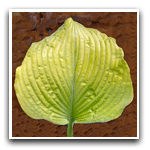 There are 3
official "base" colors which may be applied to
describe hosta leaves. A base color is one
that covers 60% or more of the surface of the leaf. Base
colors include blue-green (commonly called blue), green
(ranging from chartreuse to dark green) and
yellow (including so-called "gold" colors). There are 3
official "base" colors which may be applied to
describe hosta leaves. A base color is one
that covers 60% or more of the surface of the leaf. Base
colors include blue-green (commonly called blue), green
(ranging from chartreuse to dark green) and
yellow (including so-called "gold" colors).
A few highly variegated cultivars have the
color white covering 60% of the leaf, however, white is not
considered one of the base colors.
More about
Hosta Leaf Colors. |
|
 |
|
 |
|
 |
|
 Leaf
variegation occurs due to either the complete or partial
absence of the green molecule,
chlorophyll, in the plant's tissue. Variegation expresses itself in shades of white, yellow
or various intensities of green or blue-green. Leaf
variegation occurs due to either the complete or partial
absence of the green molecule,
chlorophyll, in the plant's tissue. Variegation expresses itself in shades of white, yellow
or various intensities of green or blue-green.
Determining which
category fits a particular hosta is not always easy. We
tried to base the variegation type on the location of
the chlorophyll influenced base colors; green and
blue-green or yellow/gold. For instance if the large size center of the leaf is
yellow with a relatively narrow band of green in the
margin, is it a green hosta with yellow medial (center) variegation or
a yellow hosta with green marginal variegation? We would call it yellow
marginal variegation since yellow covers 60% of the
surface and is the base color of this leaf.
There are three locations where variegation commonly
occurs
in hosta leaves including:
|
|
|
|
 |
|
 |
|
 |
|
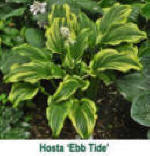 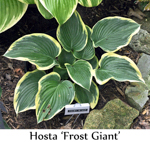 There are several
colors that may appear in contrast to the base color of a
variegated hosta leaf. These would include yellow (light
yellow to
gold), white (which includes pure white, near white and
cream colored), green (usually a lighter or darker shade
than the base color) and blue-green. There are several
colors that may appear in contrast to the base color of a
variegated hosta leaf. These would include yellow (light
yellow to
gold), white (which includes pure white, near white and
cream colored), green (usually a lighter or darker shade
than the base color) and blue-green.
More about Hosta
Variegation Colors. |
|
 |
|
 |
|
 |
|
New hostas are created
or occur naturally in several ways including:
More about
Hosta Hybridizing.
|
|
|
|
 |
|
 |
|
 |
|
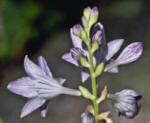  Hosta
flowers generally range in color from white to near-white to various shades of
lavender and purple. Some blossoms have stripes on them or translucent edges on the tepals (hostas have tepals
rather than petals). Hosta
flowers generally range in color from white to near-white to various shades of
lavender and purple. Some blossoms have stripes on them or translucent edges on the tepals (hostas have tepals
rather than petals).
We always try to
list the base color of the flower in our database.
Unfortunately, for some reason, even when a hosta is
registered with the
AHS, information on flower color and
season is often missing.
There is at least one hosta, H. 'Miracle
Lemony' which has
yellowish colored flowers. Also,
many hybridizers are attempting to breed hostas with
various shades of
red in their blooms.
More about Flower Color. |
|
 |
|
 |
|
 |
|
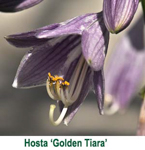 This refers to the
approximate timeframe in which flowers are borne on a
particular hosta cultivar or species. Generally, bloom times are given in
a range of calendar dates but the actual flowering time may vary by garden location
(north vs south) and type of growing season. This refers to the
approximate timeframe in which flowers are borne on a
particular hosta cultivar or species. Generally, bloom times are given in
a range of calendar dates but the actual flowering time may vary by garden location
(north vs south) and type of growing season.
The hosta registration form
lists: Before June 1, 6/1 to 7/15, 7/15 to 8/15, 8/15 to
10/1 and After 10/1. Unfortunately, many hostas are
described as flowering in "July" or "early August" which
does no fit neatly into the official registration dates so
we try to make them fit the standard dates as closely as
possible.
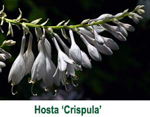 Based on the information
sources we enter bloom dates as June, June into July,
July, July into August, August, August into September,
September, September into October and October. Based on the information
sources we enter bloom dates as June, June into July,
July, July into August, August, August into September,
September, September into October and October.
Although hosta
originators are asked to list specific bloom dates,
it might be just as useful to think in terms of early, mid
or late season blooming rather than to expect a plant to
bloom the last week of June every year. Oh, well.
More about
Bloom
Season. |
|
 |
|
 |
|
 |
|
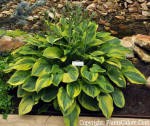  This is the
year in which the cultivar was accepted for
registration
by The American Hosta Society.
Each year, the
AHS publishes a document that announces all the
cultivars that successfully completed registration during
the previous calendar year. The release of this document completes
the official registration process. For example, registration
forms completed in 2020 are not truly registered until the
publication is issued sometime in 2021. This is the
year in which the cultivar was accepted for
registration
by The American Hosta Society.
Each year, the
AHS publishes a document that announces all the
cultivars that successfully completed registration during
the previous calendar year. The release of this document completes
the official registration process. For example, registration
forms completed in 2020 are not truly registered until the
publication is issued sometime in 2021.
Unfortunately, for a
variety of reasons, a fairly large percentage of new (and
old) hosta cultivars are
not registered with
AHS.
These are signified by an "- NR -" in this column.
More about
Hosta Registration. Also,
Lists of
Registered Hostas |
|
 |
|
 |
|
 |
|
This column designates
the people or entity involved with the origination and/or
registration of a new
hosta cultivar. Generally the names listed fall into two
categories.
-
Originators are those
people or enterprises involved in the "creation" of the
cultivar. These are the ones who hybridized, selected or
discovered a new plant as a sport or seedling.
-
Registrants
are the people or organizations who registered the cultivar with
the
The American Hosta Society. In a large number of cases, one person or entity is both the
originator and registrant. However, in others, it can be two
or more different names.
  For older, "historic" cultivars which were
introduced before registration became available, another person
may have completed the process on behalf of the now deceased
originator. Some plants that originated outside the U.S.
have also been handled in this manner also. For example,
Peter Ruh
has registered many, many cultivars on behalf of other
originators for a variety of reasons. For older, "historic" cultivars which were
introduced before registration became available, another person
may have completed the process on behalf of the now deceased
originator. Some plants that originated outside the U.S.
have also been handled in this manner also. For example,
Peter Ruh
has registered many, many cultivars on behalf of other
originators for a variety of reasons.
Also, The American
Hosta Society itself has registered many cultivars
on behalf of some of the early pioneers of the hosta
world and others. So "AHS" may appear as the source of hosta
cultivars although the organization itself has not actually
originated any hostas.
BTW - The registration
process also allows for recognizing the person who
named the
hosta cultivar and the person or business who
introduced it
into commerce. We do not list these names in our database
but, if you are interested, they will appear on the official
registration materials at the
Hosta Registrar's website.
|
|
 |
|
 |
|
 |
|
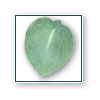  The
plant from which seeds are harvested is called the pod parent and it
is the "mother" of the next generation of hostas. Often, only the
pod parent can be identified because the flower was pollinated by
bees and the source of the pollen is "unknown". Bees are
notoriously bad record keepers. Plants with unknown pollen parents
are often referred to as
open-pollination.
See Origin above. The
plant from which seeds are harvested is called the pod parent and it
is the "mother" of the next generation of hostas. Often, only the
pod parent can be identified because the flower was pollinated by
bees and the source of the pollen is "unknown". Bees are
notoriously bad record keepers. Plants with unknown pollen parents
are often referred to as
open-pollination.
See Origin above.
More about
Pod Parents.
|
|
 |
|
 |
|
 |
|
 The
plant that provides the pollen which fertilizes the eggs resulting
in seed production is called the pollen parent i.e. the father. Most
hybridizers carefully record the name of the plant from which they
took the pollen when making precise crosses. However, many, many
hybrids come from matings where the pollen parent is not known since
the pollination was done by the bees wandering around the hosta
beds. See Origin above. The
plant that provides the pollen which fertilizes the eggs resulting
in seed production is called the pollen parent i.e. the father. Most
hybridizers carefully record the name of the plant from which they
took the pollen when making precise crosses. However, many, many
hybrids come from matings where the pollen parent is not known since
the pollination was done by the bees wandering around the hosta
beds. See Origin above.
More about
Pollen Parents.
|
|
 |
|
 |
|
 |
|
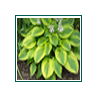 When
a plant makes a "spontaneous" change in one or more of its parts,
the new tissue is known as a "sport". Hostas are among the plants
that seem to make these changes fairly frequently. Sometimes one
division on the plant will suddenly change from an all-green plant
to one that has some leaves that have a yellow variegated margin. When this
change occurs in the garden or in nature, we call it a garden sport.
During the high tech process of tissue culture propagation, a higher
percentage of hostas seem to mutate into sports. See
Origin above. When
a plant makes a "spontaneous" change in one or more of its parts,
the new tissue is known as a "sport". Hostas are among the plants
that seem to make these changes fairly frequently. Sometimes one
division on the plant will suddenly change from an all-green plant
to one that has some leaves that have a yellow variegated margin. When this
change occurs in the garden or in nature, we call it a garden sport.
During the high tech process of tissue culture propagation, a higher
percentage of hostas seem to mutate into sports. See
Origin above.
More about
Sport Parent.
|
|
 |
|
 |
|
 |
|
At
times, the background of a hybrid hosta is presented in the form:
(’Big Ben’ x ‘Trixi’)
x [(’Tot Tot’ x ‘Darla’) x (’Macho’ x
‘Rhino’)]. This is called a Complex Cross.
 In this case, we learn about the
parents of the pod (female) parent and
the grandparents of the pollen (male) parent
but neither the actual pod or pollen parent are named. Although we
know a lot about the plant’s heritage, we do NOT know the name of
the parents so the parentage should probably be listed as “unknown”.
In our Database, we enter this information as
the
Genetic
Background of the hosta cultivar. In this case, we learn about the
parents of the pod (female) parent and
the grandparents of the pollen (male) parent
but neither the actual pod or pollen parent are named. Although we
know a lot about the plant’s heritage, we do NOT know the name of
the parents so the parentage should probably be listed as “unknown”.
In our Database, we enter this information as
the
Genetic
Background of the hosta cultivar.
The complex cross shown above is like saying
that Mary Smith and Jim Jones had a daughter. Judy Right and Bob
Wrong had a daughter and Lily White and Ben Palmer had a son and
these two kids got
married. These two unnamed people had a son who married Smith and
Jones daughter. They then had a son who they named Billy. What are the names of
Billy's parents? We don't know from the information presented. We
only know the mother's parents and the father's grandparents.

 I'm not sure why hybridizers do not
name parent plants that they use. I suppose there are cases where
the parent plant is a seedling that has some undesirable traits but
also has some traits the the hybridizer wants to pass on to the next
generation. Therefore, they feel the parent plant does not warrant
naming and introduction as a new cultivar in its own right. I'm not sure why hybridizers do not
name parent plants that they use. I suppose there are cases where
the parent plant is a seedling that has some undesirable traits but
also has some traits the the hybridizer wants to pass on to the next
generation. Therefore, they feel the parent plant does not warrant
naming and introduction as a new cultivar in its own right.
Some hybridizers use a large group of
hostas which are only given a number for a name.
Jerry Hadrava
of Iowa, for example, had around 18 breeding hostas in his
RD
numbering system that he used as parents for a large number of
plants in his
Rosedale
Series. To our knowledge, although these plants are in the
background of dozens of other hostas, none of them was ever given a
true cultivar name.
More about
Complex Crosses.
|
|
 |
|
|
 |
|
|
|



